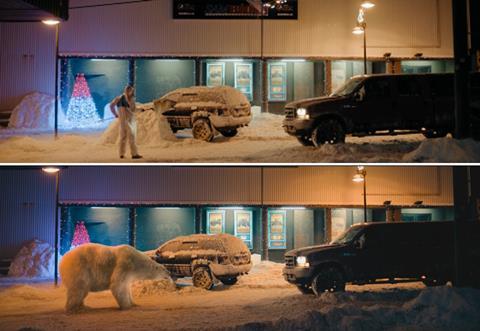The VFX supervisor on True Detective: Night Country Barney Curnow breaks down how visual effects played a role in some of the show’s most gruesome and snowiest scenes.

True Detective: Night Country’s VFX supervisor Barney Curnow had not anticipated his workload to be quite so big. “The nature of the show being so outdoors, and weather-dependent meant there ended up being a lot of stuff that we couldn’t directly plan for,” he explains of the Alaska-set Iceland-shot series starring Jodie Foster and Kali Reis.
The result was over 1000 shots using VFX, originally expected to be 700-800, from the memorable opening sequence to some of Night Country’s more gruesome scenes as well as the town’s Alaskan features. Nine different VFX vendors were brought in to work on specific scenes, such as London-based BlueBolt and US-based Encore. The show’s $60m budget included “quite a big slush fund for the unexpected” Curnow says.
Even the most expected shots underwent several changes by the time post-production rolled around in April 2023 - filming having started in November 2022 after five months of prep. The polar bear, which plays a significant role in connecting the show’s two protagonists, was originally malnourished in pre-visualisation before rewrites called for a “plumper” look.
“The shots of [the bear] are all quite lingering as well. You’re there looking at this thing so, it needs to stand up to a fair bit of scrutiny,” says the supervisor who used London-based Cinesite for the animation. The eyes, Curnow explains, are usually the trickiest part to get right when doing creature work. “When you look into an animal’s eyes, you’re very aware you’re looking into something that’s not human,” he says. “Getting that glassiness right is very important because otherwise it is very jarring. It’s a very sensitive thing.”
Dead of night

Filming in Iceland, in and around Reykjavík mostly, helped accommodate the story unfolding during Alaska’s ‘polar night’ where darkness envelops the fictional town of Ennis 24/7. “We were dealing with a lot of blackness and shooting at night has its own challenges,” Curnow explains. “[With] visual effects on material shot at night, you have quite fine tolerances in terms of what’s visible and what’s not.”
This included the exteriors of Tsalal Station, where the missing scientists were based, which was created by London-based studio Rumble. Ensuring the digital model sat correctly on the landscape meant using motion tracking, which had to be carried out in sunlight for visibility before day-for-night colour grading was employed. “It’s a notoriously tricky thing,” Curnow explains. “It’s something that always catches my eye in other shows when it’s not done very well. To still make it that you see enough, and you can make sense of what light there is. To get the brightness of the sky versus the hills in front of them and that kind of thing.”
As for the snow, which also seemingly envelops the town 24/7, the production was luckier than most in how much mother nature provided on the ground, particularly when production moved up north to Akureyri. When they needed it falling from the sky, the VFX team worked closely with special effects – the former stepping in when using a snow fan was not suitable for a dialogue-heavy scene.
One example was the scene where Chief Danvers and Trooper Navarro find their lead suspect Clark frozen to death in a storm. “The prosthetics team had built this wonderful dummy of Clark but because of the wind machine, it was wobbling around and when you looked closely you could see it was made of silicone,” Curnow explains. All the shots had to be completely picked apart and rebuilt again using a 3-D model of Clark before adding back in the snowy features.
“Hopefully no one will know we’ve done it,” Curnow says. “Particularly on this show, I didn’t want anyone talking about the visual effects because it would just distract from the world and the story.” For a VFX supervisor, audiences not noticing there are any effects at all is the best part of the job. “They might know now though,” Curnow adds jokingly.
This story originally appeared on our sister site KFTV.
























No comments yet